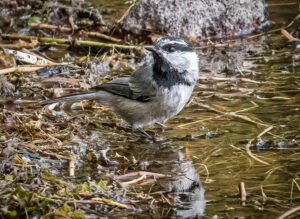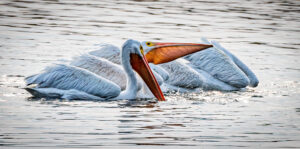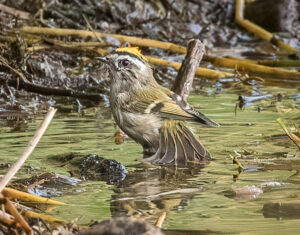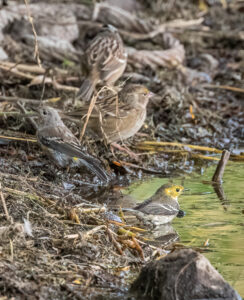
Now and again a captivating moment in nature—often completely confusing to local sensibilities—is so remarkable that it’s worth noting. That happened to a group of friends at the Rocky Point day use area (and boat launch) adjacent to the Rocky Point Resort and RV park. This is a spot we often visit en-route to the Wood River marsh and points east.

On this particular occasion, we pulled in for a comfort stop and a look in the nearby Willows that are often full of surprises. Sooney once saw a White-headed Woodpecker and we’re still waiting for it to reappear. On this occasion, the first thing that caught my attention was a cluster of American Pelicans fishing not far off shore. The image of the pelicans’ heads bobbing up, then submerging, then rising up, and then down conjured up a memory from my childhood in Los Angeles.
Not far from our home in La Cañada is the coastal community of Long Beach. In the 1920’s, a massive oil field was discovered there and, at that time, was one of the largest producers of crude oil in the world. The method of extracting the oil was using “pumpjacks” that looked just like a see-saw to a 5-year-old. That was before the days of directional drilling, so the wells were placed directly above a reservoir. When the flow was no longer profitable, the property was sold to real estate developers and became what is now “Signal Hill. Interestingly, there are still a few “pumpjacks” scattered throughout the neighborhood, plugging away while polluting the area with a toxic bouquet of diesel.
70 years later, the choreography of those Pelicans closely resembled that of those ancient extraction wells. Up, down, up, down. Tirelessly. On one or two occasions, the flapping shape of a fish could be seen in a Pelican’s sack.

Sooney gave a whistle that got our attention. She was on the shoreline, looking in some shrubbery hanging over the calm water of Upper Klamath Lake. We followed her gaze and noticed a bird bathing among the rocks in the shadow of the tree. A moment later, another bird dropped down and replaced the first bird. Only this new bird was another species. After a quick splash, the second bird flew up into the foliage only to be replaced by yet another species. “What’s going on,” we asked ourselves as, by now, all 6 of us were socially distanced along the shore, binoculars focused and cameras bursting away.

For the next 20 minutes, we watched no fewer than 16 different species of birds drop down, bathe in the shallow water, and then retreat into the Willow to dry off. On more than one occasion, we witnessed two, then three and, at one point, FOUR different bird species all bathing simultaneously within a foot of each other. This was clearly an epic sighting, and I attempted to put it into perspective. We’d seen solitary—and even a few—birds bathing in freshwater before. Ruby Lake campground, Rye Springs and Butterfly Creek come to mind. But not with the variety of wildlife and social familiarity demonstrated at Rocky Point. Sooney speculates that it was simply a hotspot with all the environmental characteristics needed by migrating birds: water, food, and protection. But, sixteen species, all in one spot at the same time?
Here’s a list of the birds we saw in just that memorable 20 minutes (we’d seen several other species earlier that day, including the American Pelicans, Coots, Pied-bill Grebes, Great Blue Herons, and a Great Gray Owl): Golden-crowned Sparrow, White-crowned Sparrow, Red-breasted Nuthatch, Townsend’s Warbler (adult and immature), Dark-eyed Junco, Mountain Chickadee, Chestnut-backed Chickadee, Cassin’s Finch, Purple Finch, Hermit Thrush, Hermit Warbler, Yellow-rumped Warbler, Black-throated Gray Warbler, Golden-crowned Kinglet, Orange-crowned Warbler, Yellow Warbler, and several Wilson’s Warblers. Whew!
